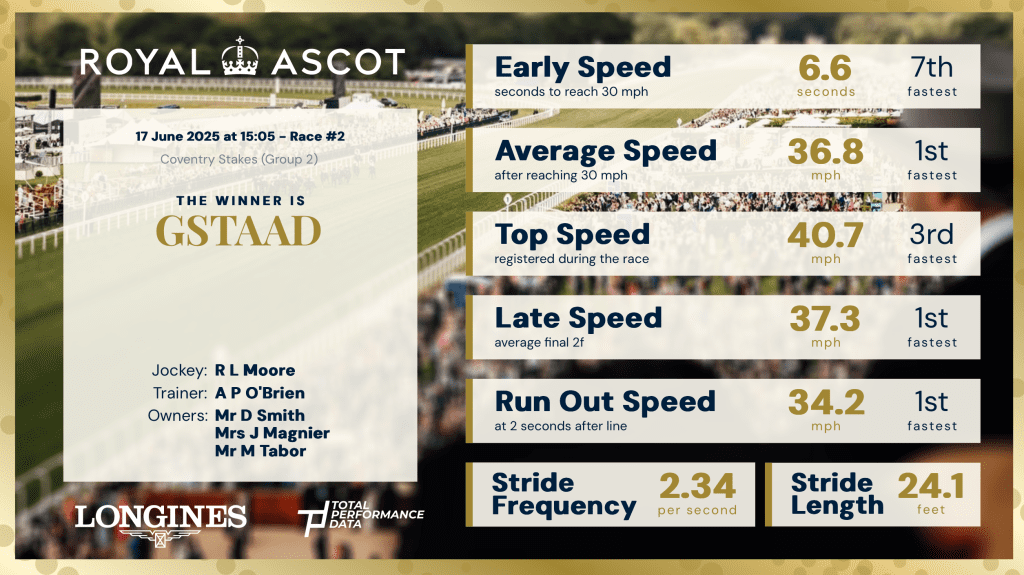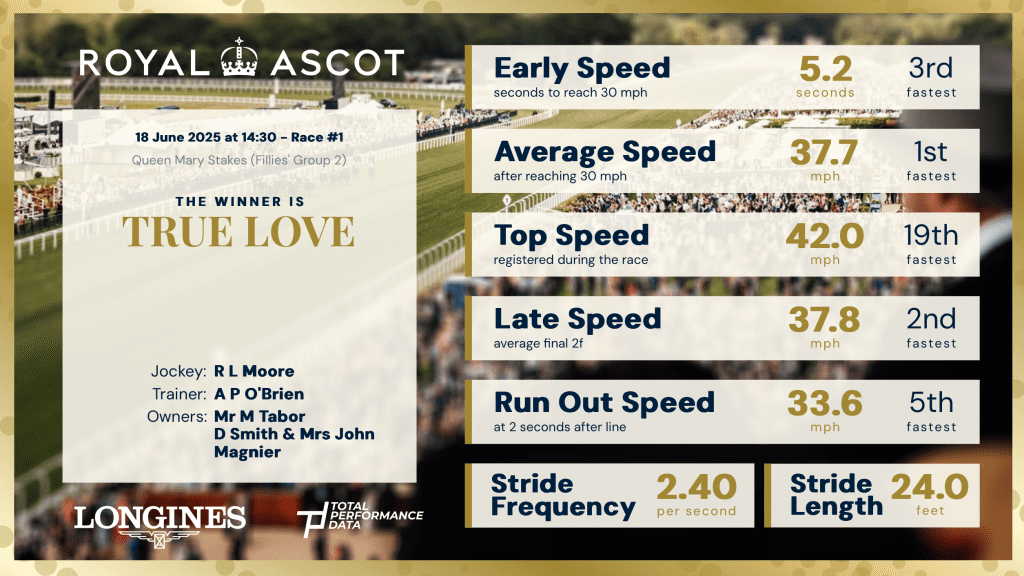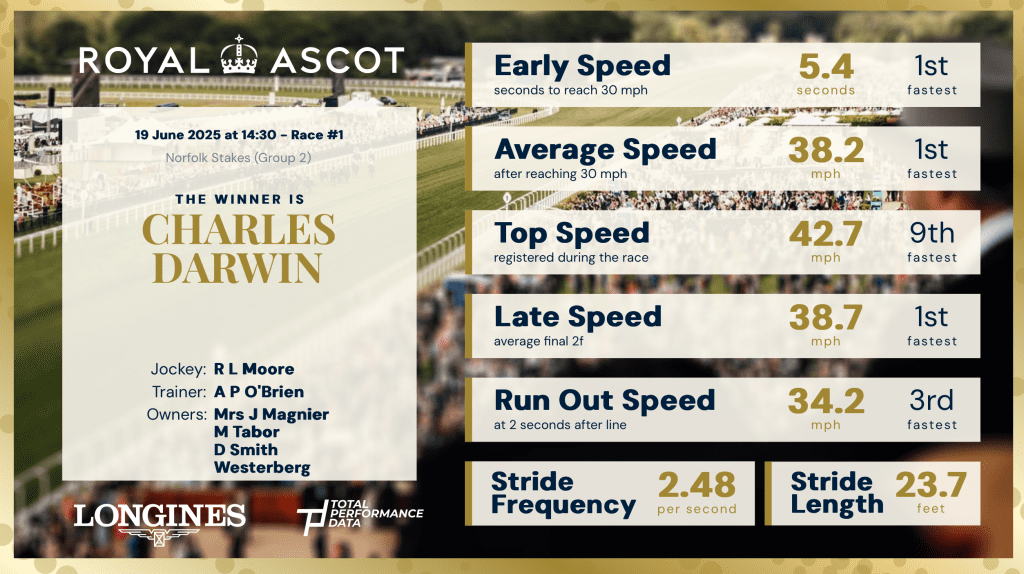Aidan O’Brien and Ballydoyle may have been out of luck in the Group 1 races last week, but their Juvenile team certainly lit up Royal Ascot with 3 winners across the 6 races for the 2-year-olds. Trying to assess any 2-year-old form can be difficult. They are by their nature, still maturing and some are far more precocious than others. However, the straight course at Ascot, even with the occasional draw bias, can help to form an idea of a pecking order and I’ve used the data from last week to assess each of the Ballydoyle winners and what they might have achieved.


Gstaad – Coventry Stakes
A 3-length winner of the Coventry Stakes, Gstaad produced a winning time of 1:13.43, which was 0.72s below the TPD Expected time under Good to Firm conditions and the fastest winning time since Bradsell in 2022. Given the obvious track bias towards the stands side rail on the opening 3 days of the meeting, we can upgrade the fact that Gstaad was ridden down the centre of the course by Ryan Moore, even if we have to allow for the fact that the 3rd placed Coppull, who ran on the stands side, was only 0.17s below that expected time figure. We saw plenty of “speedy” 2-year-olds last week and with a top speed of 40.67 mph, Gstaad certainly isn’t slow (top speed ranked 3rd), but if there is a Juvenile winner who should progress as they step up in trip later in the season from last week, it is this horse. An average stride length of 23.92 ft saw him ranked 1st in this field and he was the fastest horse in each of the last 2-furlongs, closing in 11.65 and 12.53s. A run-out speed of 34.23 mph was a clear best in this field (next best; Do or Do Not 33.87 mph) and given the way he hit the line, a step up to 7-furlongs later in the year should be well within range. As a half-brother to Vandeek, comparisons will obviously be drawn between the 2, but Gstaad appears to be more likely to stay further given that he has recorded the longest stride on both starts to date. It’s hard to get a grip on the pecking order at Ballydoyle and the fact that we didn’t get to see either Albert Einstein or Italy last week means that we can’t directly compare them all, but right now a case can be made from the data that he is the most likely type to win a race like the Dewhurst or the National Stakes in a few months time, though there is every chance that one of his stablemates will subsequently surpass him in the weeks ahead.


True Love – Queen Mary Stakes
Her earlier form with Gstaad had taken a huge boost the day before and so it was no surprise to see True Love being heavily backed before the opening race on day 2, but despite a comfortable win, she is the hardest of these 3 winners to assess. We can be sure that Gstaad was the best horse in the race in the Coventry Stakes, but the picture with True Love is certainly murkier. As we can see from the graphic above, she ranked 19th for Top Speed and although she drifted into the centre of the track in the closing stages, a high draw certainly appeared to be the place to be on Wednesdays card. Having the early speed of Zelaina to guide surely helped and I don’t think it is a coincidence that she ran the fastest penultimate furlong in the field (11.44s) at the point that rival began to tire. Her average stride length of 23.75 ft was the longest in the field and there’s no doubt that she deserved to win, but the runner-up ran the faster final furlong in 12.20s and given that True Love had the best of the draw, there’s a slight element of doubt about the form. The flip side to this is that the next best horse drawn 20 or higher was the 14th placed Justice Twice and True Love did leave the remainder of the stands side group far behind, but the winning time was just 0.2s below the expected time and if I had to take on a Juvenile winner from Ballydoyle, she would be the one.


Charles Darwin – Norfolk Stakes
This was an interesting piece to write, but once I began to look at the data, it became obvious that Charles Darwin should be top of the pile. He recorded an average stride frequency of 2.49 per second, which was the highest average recorded by any winner last week. The 5.4s that he took to reach 30 mph from the gate had so many of his rivals in difficulty from an early stage as he ran the fastest opening furlong in 13.93s. His top speed of 42.73 mph was ranked 9th, but having that explosive speed from the stalls meant that he was ideally placed. For a brief moment, he looked in trouble at the 2-furlong pole, but he quickened again, reaching a race peak average of 2.52 strides per second and running the fastest penultimate furlong in the race in 11.25s. A winning time of 58.87s was 0.98s quicker than the TPD expected time under these conditions and that made him the fastest winner of the Norfolk Stakes since his Sire, No Nay Never in 2013. Could he beat the older horses? That’s a difficult call and given that he raced on a different day it’s hard to give an exact comparison. However, what we can say is that his early speed would have seen him in front after a furlong in the King Charles III Stakes and if he had run the same furlong times, he would have ranked 1st, 5th, 1st, 1st and 1st. It’s nowhere near that simple to make this kind of comparison, but with a 2-year-old weight allowance in a race like the Nunthorpe, the data would at least suggest that it would be worth a try.